MCSA – Motor Current Signature Analysis
MVS ACMEI is the ideal partner for troubleshooting, quality control and predictive maintenance of electric motors, transformers and generators.
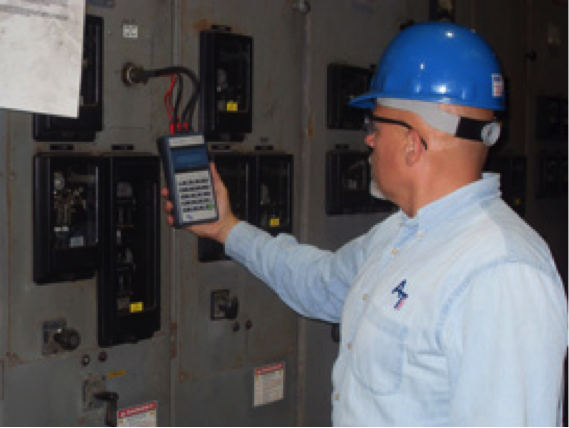
MVS ACMEI provides industry with the most advanced predictive maintenance testing and troubleshooting tools for AC and DC motors, coils, windings, transformers, generators and more to a wide range of industries worldwide. With a full line of testing instruments, software, accessories and training programs. MVS ACMEI has the tools you need to perform advanced non-destructive motor testing and analysis for both de-energized motor circuit analysis and energized electrical signature and power analysis.
The extensive capabilities of the instruments, coupled with dependable trained and technical experts, ensure improved productivity, reduced downtime and a rapid return on investment.
MOTOR TESTING SERVICESOur trained experts using most advanced motor testing equipment with intuitive integrated software,perform testing and report on equipment trending and analysis with a single hand-held instrument. De-energized testing on motors provide early detection of internal winding faults for predictive maintenance, quality control and troubleshooting. Energized motor testing models provide immediate information about incoming power and mechanical and electrical health, as well as analysis of the driven load. Built-in memory allows for storage of test data for reference.
APPLICATIONS
MVS ACMEI MCA & ESA presently used in commercial, government and military institutions across India . Applications include AC/DC electric motors; transmission and distribution transformers; machine tool motors and servo motors; AC/DC traction motors; and more.
MCA - De-Energized testing using Motor Circuit Analysis
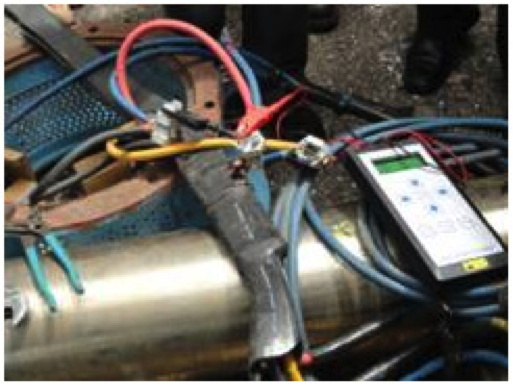 De-energized Testing in Place
De-energized Testing in Place
Motor Circuit Analysis (MCA™) is a de-energized test method and the test can be initiated from the Motor Control Center (MCC) or directly at the motor. The advantage to testing from the MCC is the entire motor system, including the connections and cables between the test point and the motor, is evaluated.
MVS ACMEI experts using ALL-TEST PRO MCA™ instruments apply a low voltage, non-destructive AC signal through the motor windings and measure the response to these signals. Winding faults are indicated by variances in the response to the applied signal through the windings. These variances cause unbalances in the measured response to the applied signal. Therefore, when testing 3-phase equipment such as motors, generators, or transformers the response of each phase is compared to the other two. When testing single phase devices or DC motors then the winding is compared to itself or compared to a like single phase device or a like DC motor.
ALL-TEST PRO MCA™ test instruments measure the phase angle (Fi), the current/frequency response (I/F), the impedance (Z) and depending upon the instrument, the resistance (R) and the inductance (L) of each winding. The unbalances of these measurements are compared and simple rules are used to determine the condition of the device under test. Moreover, each instrument will perform an insulation to ground test.
De-energized Bench Testing
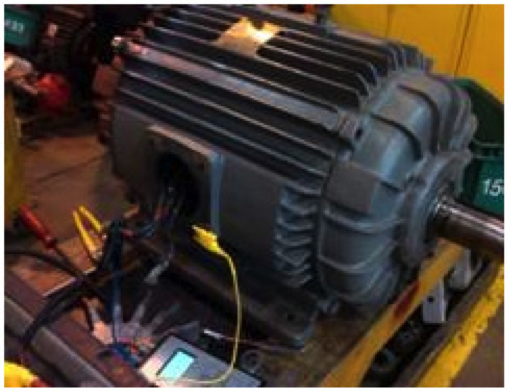
Computer software can be used to analyze the condition of the device under test and provide the user with a written report. Results can also be trended for identifying long term motor faults. I.e. used for Condition Based Maintenance or Predictive Maintenance purposes.
Additional investigation and analysis techniques are available to more thoroughly identify any of these variances in the winding so faults can be quickly and easily identified. These faults can be corrected or removed prior to energizing the winding preventing potential total destruction of the motor or other winding system.
For evaluation of the windings, whether a fault is developing between turns in a single coil, coils in the same phase, or coils across phases, the unbalance(s) between phases for the phase angle (Fi) and current/frequency response (I/F) measurements are evaluated.
The insulation to ground test is used to evaluate for conductor to ground issues. Phase resistance is evaluated looking for connection issues, inductance is evaluated for possible rotor problems, and impedance and inductance matching are used to detect contamination or over-heating of the windings.
The de-energized test takes only a few minutes and if testing from the MCC, the connections, cables and the motor are evaluated.
Successful Applications using MCA
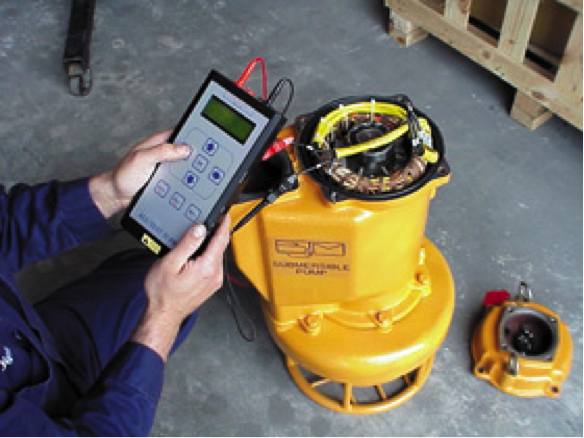
• AC/DC Motors
• Generators/Alternators
• Machine Tool Motors
• Servo Motors
• AC/DC Traction Motors
• Control Transformers
• Transmission & Distribution Transformers
• (Virtually Any Size)
• For Commissioning Testing
• For Troubleshooting
• For Reliability Testing
Other De-Energized Testing Option Limitations
Meg-ohm Meter Insulation testing will only detect faults to ground. Since only about 17% of motor electrical winding failures begin as ground faults, these faults will go undetected using this method alone.
Surge testing requires the application of high voltages and while appropriate for testing new coils it can be destructive when testing a winding (or motor) where the condition of the insulation system is unknown. This aspect, combined with the size of surge testing equipment and the need for external power to operate the instrument makes it inappropriate for troubleshooting and predictive maintenance testing.
Resistance and inductance-only (RCL) test methods don’t provide enough information for reliable fault detection and troubleshooting.
Save Money, Make Money
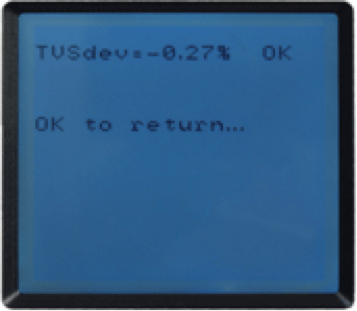
Just finding one of the faults mentioned above can save your organization countless hours of downtime and thousands of dollars in savings.
Perform a simple Test Value Static (TVS™) in just a few minutes. Use this as an initial reference as a motor specific parameter value, and to confirm the health of an induction motor. Subsequent test results can be immediately compared to the reference TVS™ to instantly show developing problems or changes with the stator or squirrel-cage rotor. A reference test can be established from the starter or motor drive, making it easy to detect changes with connections and cables, along with the motor. No need to access computer software while in the field!
Since TVS™ is a motor specific parameter it can be used as a Reference test for that particular motor. The results can be stored. Additionally, if you have multiples of the exact same motor (manufacturer/type) then the Reference test can be used for all of them. This makes incoming inspection of motors whether new or repaired very easy to perform as it only takes a few minutes per motor.
ESA - Energized Testing using Electrical Signature Analysis
Electrical Signature Analysis (ESA) is an energized test method where voltage and current waveforms are captured while the motor system is running and then, via a Fast Fourier Transform (FFT), a spectral analysis is done by the provided software. From this FFT, faults related to incoming power, the control circuit, the motor itself, and the driven load are detected and can then be trended for Condition Based Maintenance/Predictive Maintenance purposes.
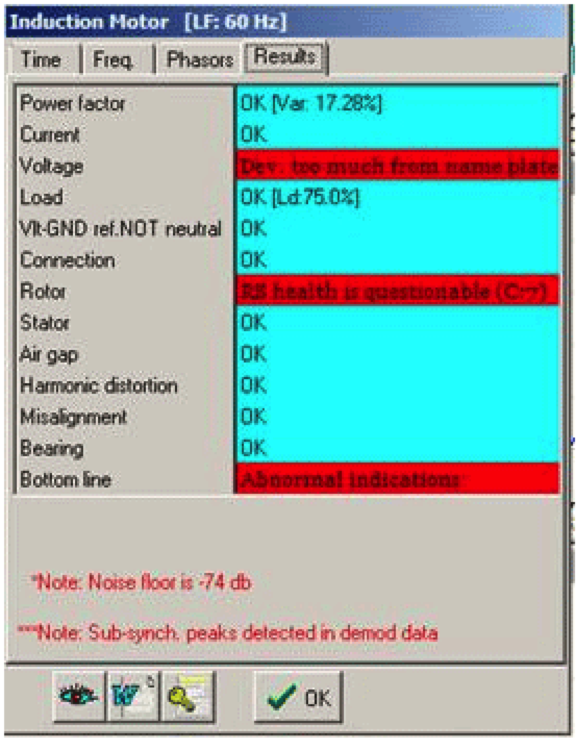
All ESA analysis systems require motor nameplate information of voltage, running speed, full load current, and horsepower (or kW). Additionally, optional information such as rotor bar and stator slot count, bearing numbers, and information for driven load components, such as blade count for a pump or tooth count for a gear box application can be entered for a more detailed and accurate analysis.
Energized testing will provide valuable information for AC induction and DC motors, generators, wound rotor motors, synchronous motors, machine tool motors, etc.
MVS ACMEI uses ALL-TEST PRO ESA instrument is actually two instruments in one - a complete Power Quality Analyzer (PQ) and complete Motor Analyzer (ESA). When in PQ mode it can be used for energy data logging, harmonic analysis, voltage and current charting, view waveforms, waveform capture of sags and swells, transient capture, and event capture.
When in ESA mode, it will provide the analyst with information about incoming power, mechanical and electrical health of the stator, rotor analysis, air gap analysis, and analysis of the driven load (gear boxes, belted applications, bearing, etc).
The key difference between Motor Current Signature Analysis (MCSA) and Electrical Signature Analysis (ESA) is with MCSA the FFT is done on the current waveform only and not the voltage. This makes it more difficult to easily and quickly distinguish incoming power related problems from motor and driven load problems. With ESA you have both the current and the voltage FFT to see on the same screen. So it is just a matter of comparing the Voltage and Current FFT spectra to determine the source of the fault.





